Abercrombie & Fitch Bundle
Can Abercrombie & Fitch Maintain Its Comeback in a Crowded Market?
Abercrombie & Fitch, once a retail giant, has impressively reinvented itself, but what does the Abercrombie & Fitch SWOT Analysis reveal about its position in the current market? From its origins as an upscale outfitter to its current status as a fashion-forward brand, A&F has navigated a complex retail landscape. Understanding the competitive landscape is crucial for investors, analysts, and anyone interested in the retail industry.
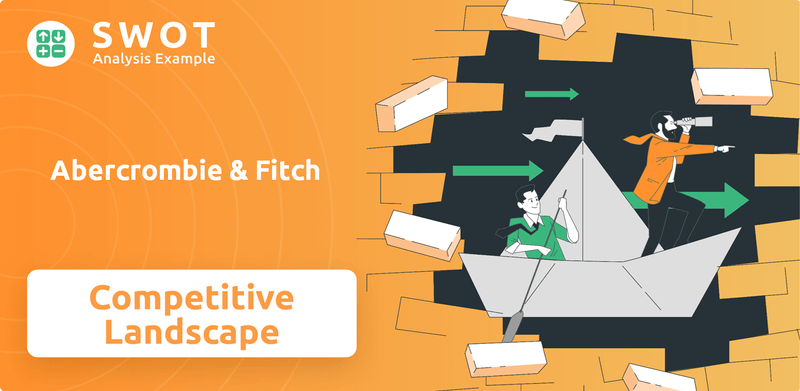
This exploration delves into the Competitive landscape of Abercrombie & Fitch, providing a detailed market analysis of its key A&F competitors. We will examine Abercrombie & Fitch's brand strategy and its brand positioning within the context of its rivals. Furthermore, we will address questions like "How does Abercrombie & Fitch compare to its competitors?" and explore the future of Abercrombie & Fitch in the dynamic retail market.
Where Does Abercrombie & Fitch’ Stand in the Current Market?
Abercrombie & Fitch (A&F) is a key player in the upscale casual wear market, with a significant global presence. The company's core operations involve designing, marketing, and selling apparel, accessories, and personal care products under its main brands: Abercrombie & Fitch, Abercrombie kids, and Hollister Co. A&F's value proposition centers on offering stylish, high-quality clothing that resonates with a specific target demographic, fostering brand loyalty through a curated shopping experience.
As of 2023, the company operated 1,070 stores across North America, Europe, and Asia, demonstrating its extensive reach. A&F's financial performance reflects a strong market position. For fiscal year 2024, net sales reached $4.95 billion, a 16% increase from the previous year, significantly outpacing the broader fashion retail market. The company aims to achieve $5 billion in sales by 2025 as part of its strategic plan.
The company's diverse brand portfolio caters to different age groups and preferences within the retail industry. Abercrombie brands target consumers aged 18-24 and young Millennials, while Hollister primarily focuses on teenagers. In FY24, Abercrombie brands saw a 16% jump in net sales to $2.55 billion, while Hollister brands experienced a 15% increase. In the first quarter of fiscal 2025, Abercrombie & Fitch reported record net sales of $1.1 billion, an 8% increase year-over-year, exceeding expectations. This growth was broad-based across regions, with the Americas up 7%, EMEA up 12%, and APAC up 5%. Hollister brands led the performance in Q1 FY25 with 22% growth, achieving their best-ever first-quarter net sales, while Abercrombie brands net sales were down 4% compared to strong growth in the prior year.
Abercrombie & Fitch's strong sales growth indicates a healthy market share. The company's ability to increase sales by 16% in FY24, while the broader market grew by only 1%, highlights its competitive advantage. This growth trajectory suggests a positive outlook for Abercrombie & Fitch's market position.
The performance of Abercrombie and Hollister brands varies, with Hollister leading in Q1 FY25. This highlights the importance of understanding the distinct target markets and brand strategies. Abercrombie & Fitch's success depends on effectively managing and growing both brand portfolios.
Nearly 50% of Abercrombie & Fitch's business is digital, showcasing its commitment to online retail. The myAbercrombie loyalty program, with 70%-80% membership, provides valuable first-party data for targeted marketing and customer engagement. This digital focus is crucial for maintaining a competitive edge.
The company anticipates tariff costs of around $50 million in 2025, which could impact operating margins. Despite strong sales, elevated costs are a challenge. The operating margin was 9.3% in Q1 FY25, down from 12.7% in the same period last year, indicating the need for cost management strategies.
Abercrombie & Fitch's market position is strong, driven by robust sales growth and a diverse brand portfolio. The company's digital transformation and customer loyalty programs enhance its competitive advantages. However, challenges such as rising costs and the need for effective brand management require strategic focus. For a deeper dive into the company's origins, check out this Brief History of Abercrombie & Fitch.
- Strong sales growth and market share gains.
- Successful brand portfolio with diverse target markets.
- Focus on digital transformation and customer loyalty.
- Challenges related to rising costs and competitive pressures.
Abercrombie & Fitch SWOT Analysis
- Complete SWOT Breakdown
- Fully Customizable
- Editable in Excel & Word
- Professional Formatting
- Investor-Ready Format
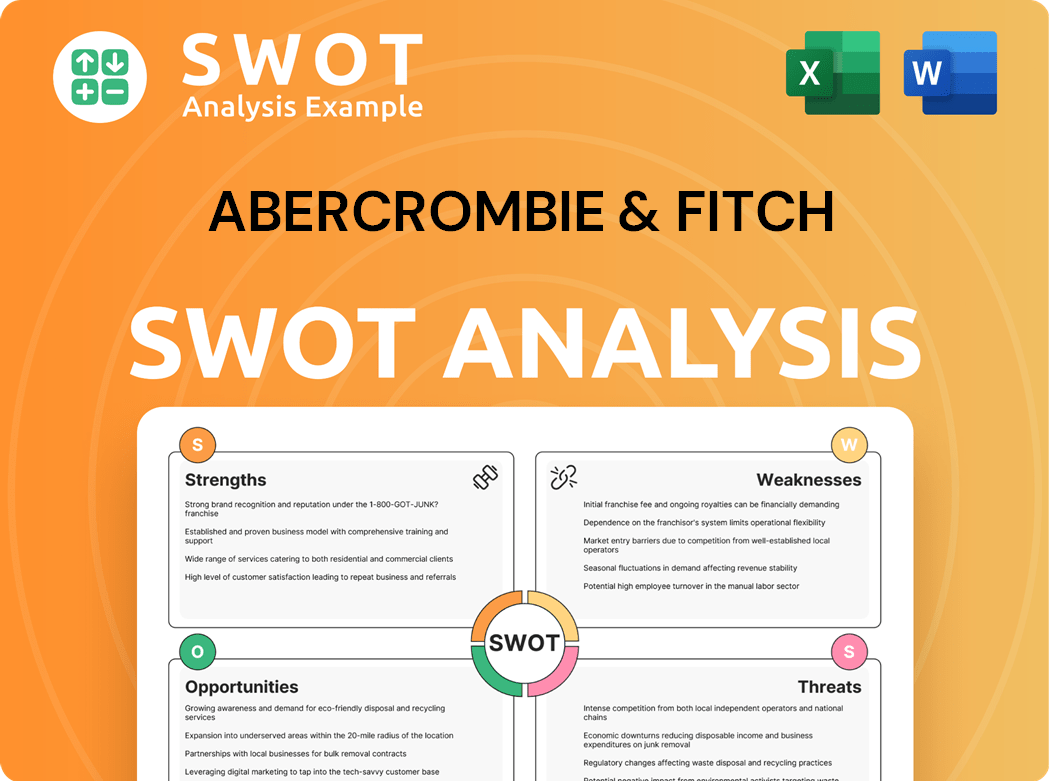
Who Are the Main Competitors Challenging Abercrombie & Fitch?
The Revenue Streams & Business Model of Abercrombie & Fitch operates within a dynamic and intensely competitive retail environment. Understanding the competitive landscape is crucial for assessing its market position and future prospects. This involves identifying both direct and indirect rivals and analyzing their strategies.
The apparel retail industry is subject to rapid changes in consumer preferences and fashion trends. Companies must adapt to stay relevant. This requires a constant evaluation of the competitive landscape to identify threats and opportunities.
Abercrombie & Fitch faces a variety of competitors in the fashion retail sector. These rivals vary in size, target market, and business model, creating a complex competitive environment. Understanding these competitors is essential for assessing its market position and developing effective strategies.
A&F competitors directly compete for the same customer base, offering similar products. These retailers often have comparable brand positioning and pricing strategies. They are the most immediate threats to Abercrombie & Fitch's market share.
American Eagle Outfitters targets a similar demographic with casual and trendy apparel. As of 2024, American Eagle Outfitters reported net revenue of approximately $1.2 billion in the first quarter. This highlights its significant presence in the market.
H&M and Zara, known for their fast-fashion models, present a challenge through their ability to quickly offer trendy styles at affordable prices. Zara's parent company, Inditex, reported sales of approximately €35.9 billion in fiscal year 2023, demonstrating their substantial market influence.
Gap is an established American retailer with a broad range of clothing and accessories. Gap's net sales for fiscal year 2023 were $14.9 billion. This showcases its continued relevance in the retail sector.
Urban Outfitters caters to a more niche market with unique and trendy apparel. Urban Outfitters reported net sales of $4.9 billion for the fiscal year 2024.
Uniqlo offers a range of basic and functional clothing. Fast Retailing, Uniqlo's parent company, reported revenue of approximately ¥3.03 trillion for the fiscal year ended August 2023.
Beyond direct competitors, Abercrombie & Fitch also competes with other apparel retailers, including Delta Apparel, Supreme, AllSaints, Jack Wills, Tommy Hilfiger, J Crew, PVH Corp, and Mango. These companies may target different segments or offer different product lines, but still impact the overall market analysis. The competitive factors in this market include brand recognition, fashion, price, service, store location, selection, and quality. The industry is also seeing new and emerging players, and mergers or alliances can impact the competitive dynamics.
Several factors influence the competitive landscape in the retail industry. These factors are critical for Abercrombie & Fitch to maintain its market position and grow. Understanding these elements is essential for a comprehensive market analysis.
- Brand Recognition: Strong brand recognition helps attract and retain customers.
- Fashion and Trends: Staying current with fashion trends is crucial for appealing to target consumers.
- Pricing: Competitive pricing strategies are essential for attracting price-sensitive customers.
- Service: Excellent customer service enhances the shopping experience.
- Store Location: Strategic store locations increase accessibility and visibility.
- Selection: Offering a wide and appealing product selection meets diverse customer needs.
- Quality: High-quality products build brand reputation and customer loyalty.
Abercrombie & Fitch PESTLE Analysis
- Covers All 6 PESTLE Categories
- No Research Needed – Save Hours of Work
- Built by Experts, Trusted by Consultants
- Instant Download, Ready to Use
- 100% Editable, Fully Customizable
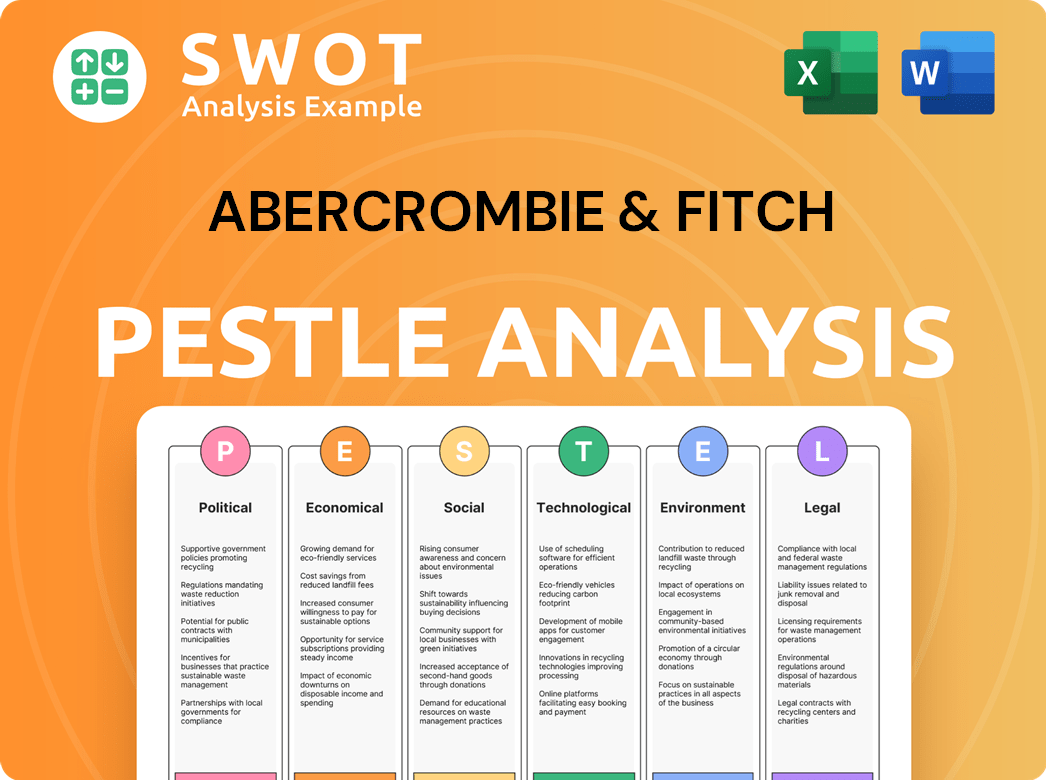
What Gives Abercrombie & Fitch a Competitive Edge Over Its Rivals?
Analyzing the competitive landscape of Abercrombie & Fitch (A&F) reveals several key advantages. The company has successfully revitalized its brand, broadening its appeal while retaining its core identity. This transformation is crucial for maintaining its market position and attracting both existing and new customer segments. Understanding the strategies of Abercrombie & Fitch's competitors is also key to assessing its strengths.
Abercrombie & Fitch's strategic moves have focused on enhancing product quality and the overall customer experience. Investments in digital capabilities and an omnichannel strategy have further strengthened its position in the retail industry. The company's ability to adapt to changing consumer preferences and market trends is a significant factor in its ongoing success. The current challenges faced by the brand are also important to consider.
A&F's financial health, including strong cash flow generation, provides flexibility for investment and growth. This financial stability allows the company to pursue strategic initiatives and respond effectively to competitive pressures. Abercrombie & Fitch's financial performance is a key indicator of its overall health.
Abercrombie & Fitch has a long-standing brand identity, which has been revamped to resonate with modern consumers. The company has leveraged its brand equity to appeal to its original Millennial customer base and the Gen Z demographic. This strategic brand positioning allows it to maintain relevance in a competitive market. Abercrombie & Fitch's brand strategy is a key element of its success.
The company's focus on high-quality merchandise and a distinctive brand experience sets it apart. Abercrombie & Fitch has invested in improving its product assortment, including expanding into categories like activewear and occasionwear. The 'Curve Love' line, designed for different body types, is an example of its commitment to quality and fit. This focus helps differentiate it from A&F competitors.
Abercrombie & Fitch has made significant investments in its digital capabilities and omnichannel strategy. A significant portion of its business is digital, supported by a strong loyalty program. This approach allows for personalized marketing and product offerings. The company's online presence compared to rivals is a critical factor.
The company's agile 'read and react' inventory model helps it respond quickly to customer demand and manage inventory effectively. Abercrombie & Fitch's improved financial health, including strong cash flow generation and liquidity, provides flexibility for investment and growth opportunities. Analyzing Abercrombie & Fitch's competitive environment shows its financial stability.
Abercrombie & Fitch's competitive advantages include a strong brand identity, high-quality products, and a robust digital presence. Its ability to adapt to changing consumer preferences and maintain financial health further strengthens its position. Understanding how Abercrombie & Fitch compares to its competitors is essential.
- Brand Transformation: Successfully revitalized its brand to appeal to a broader audience.
- Product Innovation: Investments in product assortment, including activewear and 'Curve Love' lines.
- Digital Strategy: Significant investment in digital capabilities and omnichannel presence.
- Financial Strength: Strong cash flow and liquidity providing flexibility for investments.
Abercrombie & Fitch Business Model Canvas
- Complete 9-Block Business Model Canvas
- Effortlessly Communicate Your Business Strategy
- Investor-Ready BMC Format
- 100% Editable and Customizable
- Clear and Structured Layout
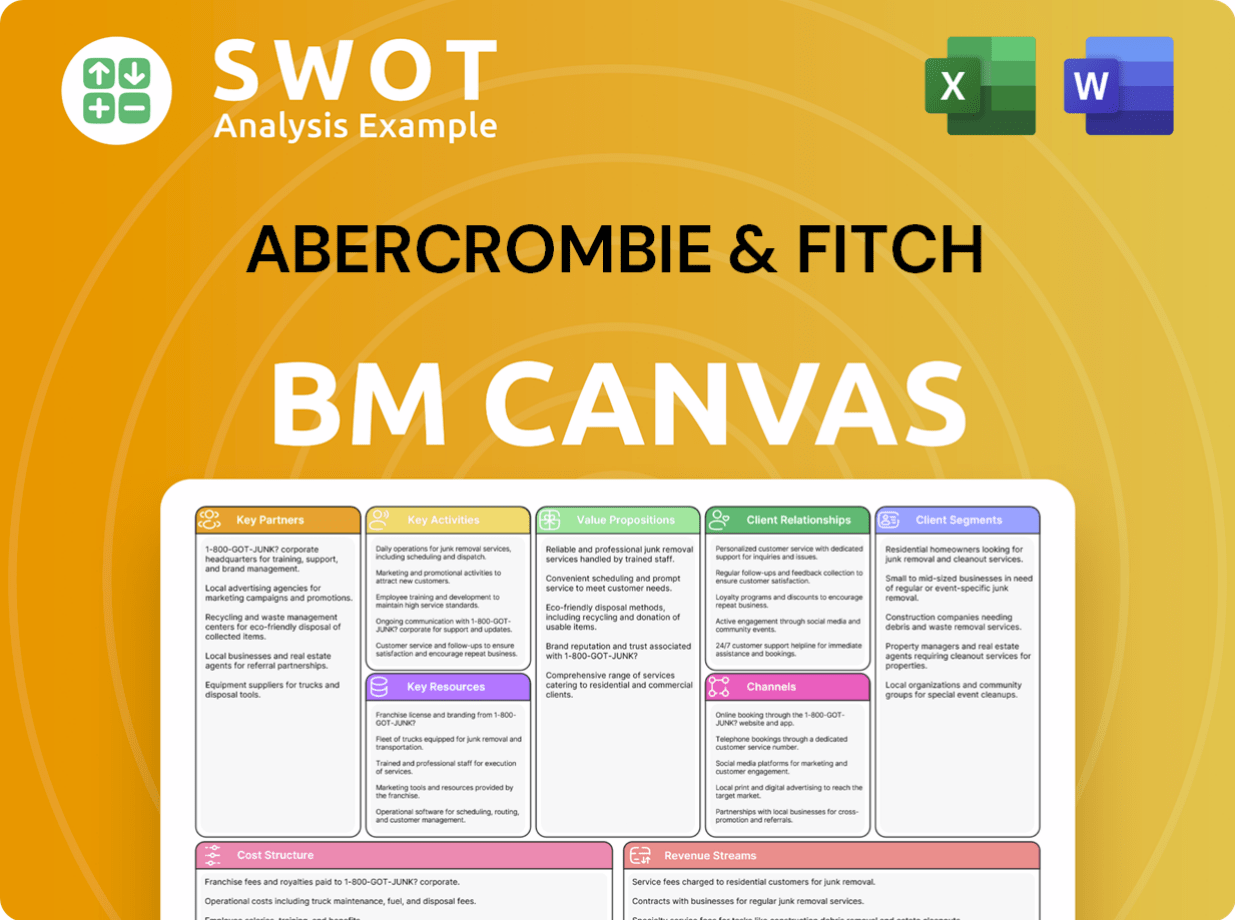
What Industry Trends Are Reshaping Abercrombie & Fitch’s Competitive Landscape?
The apparel retail industry is dynamic, significantly influenced by technological advancements, evolving consumer preferences, and global economic shifts. Understanding the competitive landscape is crucial for any company aiming to thrive. This involves analyzing market trends, identifying key competitors, and adapting to changing consumer demands. For a detailed look at their strategic direction, consider reading about the Growth Strategy of Abercrombie & Fitch.
Abercrombie & Fitch (A&F) faces both challenges and opportunities within this environment. The company’s ability to maintain its momentum depends on continuous investment in digital innovation and supply chain efficiency. The competitive landscape requires strategies to navigate increased freight costs, potential tariff impacts, and intense competition from both established and emerging brands. Abercrombie & Fitch's market share in 2024 and beyond will be influenced by its ability to adapt and innovate.
E-commerce continues to grow, emphasizing the importance of an omnichannel experience. Consumers, especially Gen Z, increasingly value inclusivity, sustainability, and authenticity. Brands are responding by focusing on these values to attract and retain customers. The retail industry is seeing a shift towards personalized marketing and building deeper customer relationships through loyalty programs.
Increased freight costs and potential tariff impacts can pressure margins. Intense competition from established players and emerging brands remains a constant challenge. Adapting to evolving consumer preferences and maintaining a relevant brand image requires continuous innovation. Supply chain disruptions and economic uncertainties pose ongoing risks.
Abercrombie & Fitch's successful rebranding and focus on inclusivity resonate with younger consumers. Expanding product offerings and exploring new international markets present growth avenues. The company's strong digital presence and loyalty program provide a platform for personalized marketing. Strategic partnerships and leveraging social media platforms like TikTok are key to reaching the target demographic.
Abercrombie & Fitch plans continued store expansion, prioritizing key markets in 2025. The 'Always Forward' strategy focuses on profitable growth and financial discipline. The company is investing in digital innovation and supply chain efficiency to enhance customer experience. Strategic partnerships and leveraging social media platforms are key.
Abercrombie & Fitch's competitive advantages include its successful rebranding, strong brand positioning, and focus on its target market. Its digital presence and loyalty program enhance customer engagement. The company's ability to adapt to changing consumer preferences and expand into new markets is also crucial.
- Successful Rebranding: Abercrombie & Fitch has repositioned itself to appeal to a broader audience.
- Digital Presence: A strong online presence and e-commerce capabilities are crucial for reaching customers.
- Customer Loyalty: Loyalty programs help build deeper customer relationships and drive repeat purchases.
- Market Expansion: Exploring new international markets offers additional growth opportunities.
Abercrombie & Fitch Porter's Five Forces Analysis
- Covers All 5 Competitive Forces in Detail
- Structured for Consultants, Students, and Founders
- 100% Editable in Microsoft Word & Excel
- Instant Digital Download – Use Immediately
- Compatible with Mac & PC – Fully Unlocked
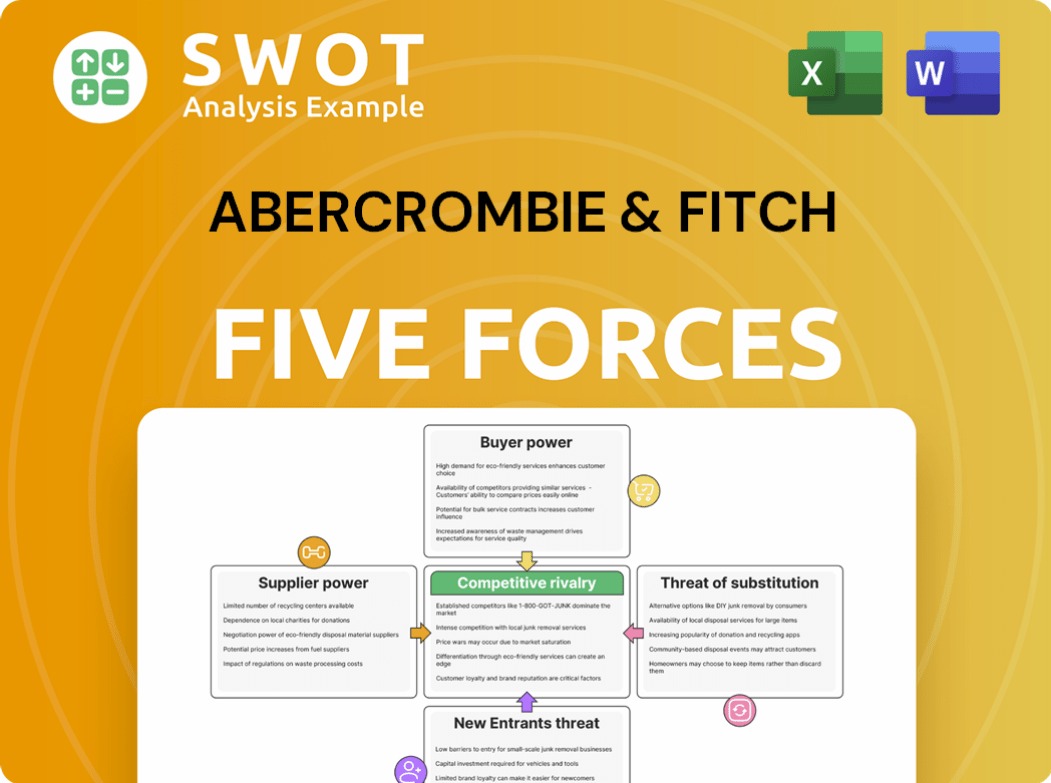
Related Blogs
- What are Mission Vision & Core Values of Abercrombie & Fitch Company?
- What is Growth Strategy and Future Prospects of Abercrombie & Fitch Company?
- How Does Abercrombie & Fitch Company Work?
- What is Sales and Marketing Strategy of Abercrombie & Fitch Company?
- What is Brief History of Abercrombie & Fitch Company?
- Who Owns Abercrombie & Fitch Company?
- What is Customer Demographics and Target Market of Abercrombie & Fitch Company?
Disclaimer
All information, articles, and product details provided on this website are for general informational and educational purposes only. We do not claim any ownership over, nor do we intend to infringe upon, any trademarks, copyrights, logos, brand names, or other intellectual property mentioned or depicted on this site. Such intellectual property remains the property of its respective owners, and any references here are made solely for identification or informational purposes, without implying any affiliation, endorsement, or partnership.
We make no representations or warranties, express or implied, regarding the accuracy, completeness, or suitability of any content or products presented. Nothing on this website should be construed as legal, tax, investment, financial, medical, or other professional advice. In addition, no part of this site—including articles or product references—constitutes a solicitation, recommendation, endorsement, advertisement, or offer to buy or sell any securities, franchises, or other financial instruments, particularly in jurisdictions where such activity would be unlawful.
All content is of a general nature and may not address the specific circumstances of any individual or entity. It is not a substitute for professional advice or services. Any actions you take based on the information provided here are strictly at your own risk. You accept full responsibility for any decisions or outcomes arising from your use of this website and agree to release us from any liability in connection with your use of, or reliance upon, the content or products found herein.